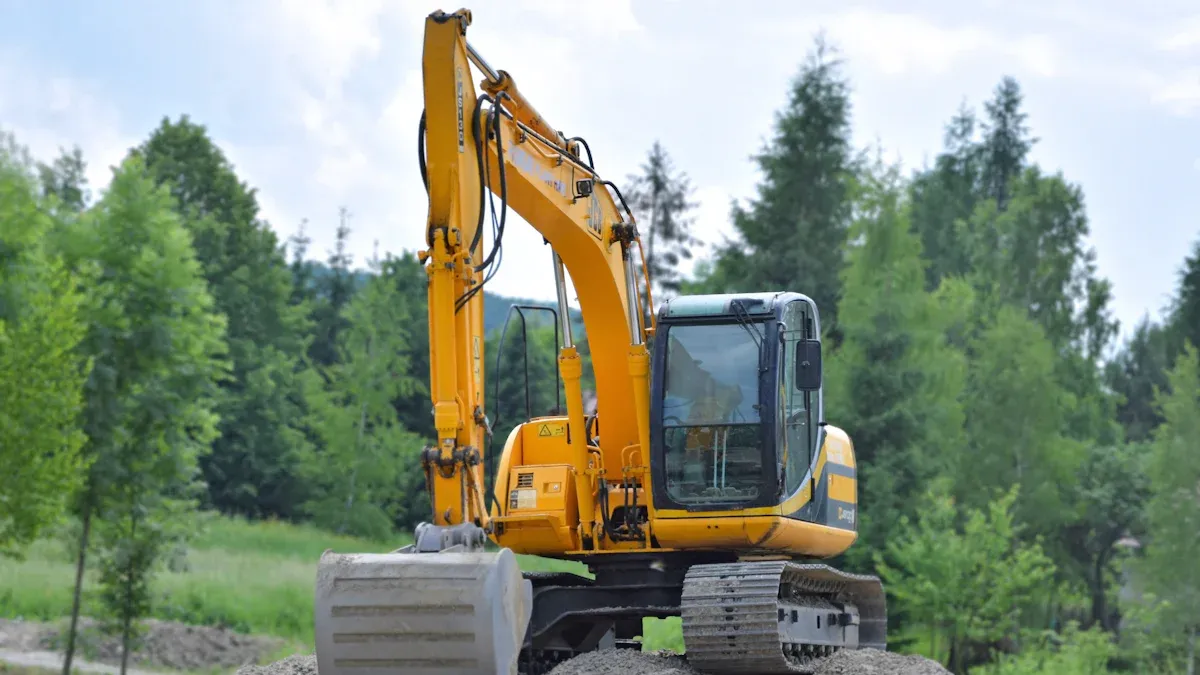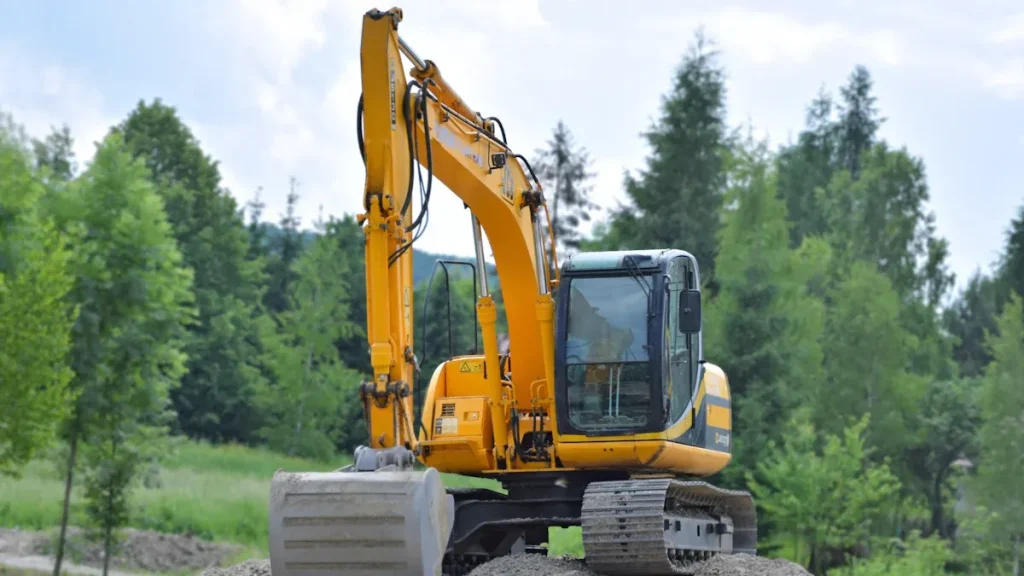
Keeping durable excavator parts in good shape saves money and time. Regular care helps avoid costly fixes and work delays. For example, checking and servicing equipment often can cut breakdowns by 70%. Spending $15,000 on upkeep can stop $40,000 in engine repairs. Taking care of your excavator also makes it last longer. Cleaning seals and filters often keeps dirt out of the engine. These simple steps make your equipment stronger and last longer. It’s a smart way to invest in construction projects.
Key Takeaways
Regular maintenance can stop up to 70% of breakdowns. Spend time on daily checks to avoid costly repairs.
Cleaning your excavator stops dirt from causing damage. Clean it every day to keep it working well.
Lubrication helps moving parts work smoothly. Use the right oil and follow a schedule to make it last longer.
Check your excavator every month for small problems. Fixing them early can save you from big repair costs.
Work with trusted service experts for inspections. Their skills and tools can keep your excavator in great condition.
Daily Maintenance Practices for Durable Excavator Parts

Pre-Operation Checks
Checking your excavator before use is very important. Look at key parts like the hydraulic system, engine oil, and coolant levels. Check the tracks for damage or stuck debris. Search for loose bolts, worn parts, or leaks that could cause problems. These quick checks help spot issues early and avoid breakdowns.
Pre-operation checks also keep the operator and worksite safe. For example, testing brakes and controls ensures the machine works properly. Spending a few minutes on these checks can save money and make your excavator parts last longer.
Post-Operation Inspections
After using your excavator, inspect it carefully. Look at the undercarriage for wear or damage. Check hydraulic hoses and seals for cracks or leaks. Inspect the bucket and attachments for dents or heavy wear.
These inspections help catch problems early and prevent bigger issues. The table below shows how post-operation checks save time and money:
Evidence Type | Description |
|---|---|
Preventive Maintenance | Regular checks reduce sudden breakdowns and equipment problems. |
Early Issue Identification | Spotting problems early stops them from becoming major repairs. |
Cost Efficiency | Preventive care costs less than fixing big failures later. |
Adding post-operation checks to your routine keeps your equipment reliable and lowers repair costs.
Cleaning to Prevent Abrasion
Cleaning your excavator protects its parts from damage. Dirt and mud can build up and cause wear over time. Regular cleaning stops debris from harming durable excavator parts. For example:
Stuck objects can loosen bolts or jam rollers.
Dirt increases friction, wearing parts out faster.
Too much dirt can age your machine quickly.
Focus on cleaning areas like the undercarriage, tracks, and hydraulic components. Use a pressure washer or special tools to remove tough dirt. Clean hard-to-reach spots where debris collects. Keeping your excavator clean helps it last longer and work better.
Tip: Make cleaning part of your daily routine to avoid damage and keep your equipment running smoothly.
Lubrication to Make Moving Parts Last Longer
Lubrication is key to keeping your excavator working well. Without it, parts rub together and wear out faster. Using the right lubricants often can lower friction, stop overheating, and help parts like bearings and pins last longer.
Here are some tips for proper lubrication:
Use the Correct Lubricant
Pick a lubricant that matches what the maker suggests. Some parts need grease, while others need oil. Using the wrong one can harm parts instead of helping them.Set a Lubrication Schedule
Add lubrication to your daily maintenance tasks. Regular greasing keeps parts from wearing out. For example, greasing bucket pins daily stops them from getting stuck.Clean Before Lubricating
Wipe away dirt before adding lubricant. Dirt can mix with grease and damage parts. A clean surface helps the lubricant work better.Avoid Over-Lubrication
Too much grease can cause problems. It can trap dirt, clog parts, or leak into unwanted areas. Use just enough to cover the parts evenly.Use Good Tools
Get quality grease guns and oil tools. These make it easier to apply the right amount in the right spots.
Tip: Keep a record of when and where you lubricate. This helps ensure no part is missed.
Lubricating your excavator protects its parts and boosts its performance. This simple habit helps your machine last longer and work better.
Scheduled Maintenance Routines to Make Excavators Last Longer
Weekly Maintenance Tasks
Doing weekly maintenance keeps your excavator in great shape. It helps find small problems early, stopping bigger, costly repairs. Spending time each week on care makes your machine last longer and work better.
Here’s why weekly maintenance is important:
You can find loose bolts or small leaks before they get worse.
Checking parts like hydraulic pumps and undercarriages helps them last longer.
Regular care lowers costs by keeping parts working longer.
Focus on areas that wear out quickly. Look at tracks, rollers, and hydraulic systems for damage. Clean and grease moving parts to keep them working smoothly. Sticking to weekly tasks helps your excavator last longer and avoids sudden breakdowns.
Tip: Use a checklist for weekly tasks so you don’t miss anything.
Monthly Inspections for Damage
Monthly checks are key to keeping your excavator safe and working well. These checks find wear and tear that daily or weekly tasks might miss. Fixing problems early stops accidents and keeps your machine running longer.
The table below shows why monthly checks matter:
Benefit | Description |
|---|---|
Safety and Efficiency | Inspections keep your machine safe and working properly. |
Early Problem Detection | Finding odd sounds or leaks early avoids big repairs later. |
Cost-Effectiveness | Fixing small issues costs less than fixing major breakdowns. |
During monthly checks, look at the engine, hydraulic hoses, and wires. Check for cracks, leaks, or worn-out parts. Replace damaged parts right away to avoid bigger problems. These steps keep your excavator reliable and strong.
Note: Write down what you check each month. This helps track problems and plan future fixes.
Annual Overhauls and Part Replacements
Yearly overhauls are very important for keeping your excavator in top shape. They include a full check-up and replacing old parts. Though it takes time and money, it helps your machine last longer.
During yearly overhauls, focus on these areas:
Engine and Hydraulic Systems: Check everything and replace old filters, seals, or hoses.
Undercarriage Parts: Look at tracks, rollers, and sprockets. Replace worn-out ones.
Electrical Systems: Test wires, sensors, and controls to make sure they work.
Fixing these parts stops sudden breakdowns and extends your excavator’s life. Overhauls also let you add new technology to improve performance.
Reminder: Plan yearly overhauls during slow times to avoid work delays.
Operator Best Practices for Prolonging the Life Span
Proper Training and Certification
Training helps you use excavators the right way. It lowers mistakes that can break the machine. Certification programs teach safe and smart ways to operate excavators. They also show how to do simple maintenance to keep the machine working longer.
Hands-on practice is very helpful. It lets you try using excavators in real situations. This helps you learn how to use them correctly in different conditions. Training managers is also important. It makes sure everyone knows safety rules and how to handle equipment.
Tip: Pick programs with both classroom lessons and real-world practice for better learning.
Avoiding Misuse and Overloading
Using excavators the wrong way can cause big problems. Overloading or using them for tasks they aren’t made for can harm parts. For example, lifting too much weight can damage the hydraulic system and shorten its life.
Follow the maker’s rules to avoid misuse. Use the right tools for each job and keep loads within safe limits. Watch the ground too. Working on uneven land can tip the machine or hurt its undercarriage.
Reminder: Treat your excavator carefully. Using it properly saves money and makes it last longer.
Safe Handling and Operation Techniques
Safe handling keeps your excavator in good shape. Learn how the controls work before starting. This helps you avoid sudden moves that wear out parts.
On the job site, drive at a steady speed. Don’t stop or turn quickly to protect the tracks and moving parts. Stay away from obstacles and other machines to avoid crashes. Always check your surroundings for a clear path.
Note: Safe handling protects your excavator and keeps workers safe too.
Proactive Repairs and Inspections to Extend the Life
Spotting Early Signs of Damage
Finding damage early can save money and time. Listen for strange sounds, feel for vibrations, or look for leaks. For example, squeaking might mean worn pins, and leaks could mean a bad seal. Regular checks help find these problems before they get worse.
Pay close attention to important parts like the undercarriage. Tracks and rollers often wear out first. Cracks, loose bolts, or uneven tracks can cause bigger issues later. Fixing these problems quickly helps your excavator last longer and avoids sudden breakdowns.
Tip: Teach operators to notice these signs during daily checks. Their attention can stop small problems from growing.
Keeping Clear Maintenance Records
Good records make maintenance easier and more effective. They help track what’s done, plan future checks, and find repeating problems. For example, if one part breaks often, you can figure out why and fix it.
Studies show keeping records lowers repair costs and prevents big problems. This method ensures no task is missed, keeping your excavator in great shape. Use apps or notebooks to log inspections, repairs, and part changes.
Note: Keeping records helps you stay organized and plan long-term care.
Fixing Problems Early
Fixing small issues early saves money and avoids big repairs. Regular care stops sudden breakdowns and lowers costs. For example:
Changing worn tracks protects the undercarriage.
Fixing leaks early saves the hydraulic system.
Tightening bolts prevents bigger damage.
Preventive care makes your equipment last longer and reduces downtime. Regular checks help find problems before they grow. Scheduling repairs at good times also saves money and keeps work on track.
Reminder: Small fixes now can stop big expenses later.
Leveraging Professional Services for Maintenance
Benefits of Expert Inspections
Professional inspections help keep your excavator working well. Experts can find hidden problems that regular checks might miss. They know how to carefully inspect every part, like the undercarriage. This lowers the chance of sudden breakdowns and helps your equipment last longer.
Hiring professionals has many advantages. These inspections reduce downtime, cut repair costs, and improve safety. For example, special tools can predict problems before they happen. Fixing issues early avoids delays and keeps work on track. The table below shows how expert inspections improve performance:
Performance Improvement | Description |
|---|---|
Reducing unexpected downtime | Tools find problems early, stopping unplanned work delays. |
Lowering maintenance costs | Early fixes save money and use resources wisely. |
Extending asset life | Regular care helps your machine last longer. |
Enhancing operational safety | Preventive care lowers the risk of dangerous equipment failures. |
Tip: Plan regular professional inspections to keep your excavator safe and reliable.
Access to Specialized Tools and Knowledge
Professional services use advanced tools and expert skills to improve care. Tools like engine testers and heat sensors find problems early. For example, an engine tester checks oil pressure and temperature to avoid big failures. Heat sensors show temperature changes in engine parts, helping fix issues faster.
Experts also follow strict steps to do maintenance correctly. Their training reduces mistakes and improves the quality of work. Combining these tools and skills makes professional services very effective.
Partnering with Reliable Service Providers
Picking a good service provider is important for proper care. Trusted providers give high-quality service to keep your machine in great shape. They understand your needs and adjust their methods to fit them.
Some providers use tools to plan maintenance based on how you use your excavator. This finds weak parts and prevents bigger problems. Working with reliable providers ensures your equipment gets the best care.
Reminder: Check a provider’s experience and reviews before hiring them.
Maintaining the Undercarriage for Long-Term Durability
Inspecting Tracks and Rollers
Checking tracks and rollers often helps avoid undercarriage damage. Look for cracks, uneven wear, or loose bolts on steel tracks. Ignoring these problems can lead to expensive repairs. Mud and debris can build up on rollers, making them jam or wear out faster. Cleaning them during checks keeps parts working well and lowers repair costs.
Modern tools can spot problems early. Predictive technology warns you before issues get worse. Regular inspections save money and keep your excavator running smoothly.
Tip: Use a checklist to make sure you check every detail.
Cleaning and Lubricating Undercarriage Components
Cleaning the undercarriage stops dirt and rocks from causing damage. After working on rough ground, clean it to keep parts strong. Use a pressure washer or special tools to remove stuck debris from hard-to-reach spots.
Lubricating parts like rollers and bearings is also important. The right lubricant lowers friction and stops overheating. Follow the manual to pick the correct lubricant for your machine. Lubrication helps parts move smoothly and last longer.
Reminder: Make cleaning and lubricating part of your regular care routine.
Replacing Worn Parts to Prevent Further Damage
Changing worn parts quickly stops bigger problems from happening. Waiting too long can turn small issues into major failures. For example, worn tracks can harm rollers and sprockets, causing more damage.
Regular checks help you find worn parts early. Replace damaged tracks or rollers before they affect other parts. Fixing these parts on time keeps your excavator working well and avoids downtime.
Note: Plan replacements during slow times to avoid work delays.
Taking care of durable excavator parts needs regular effort and focus. Daily checks stop expensive fixes and keep work on schedule. Planned maintenance helps your machine last longer. Being proactive makes sure your excavator works well and stays reliable. Training operators and hiring experts also protect your equipment. Using it properly and getting expert help keeps it in great shape.
Following these steps saves money and extends your excavator’s life. Make maintenance a habit to keep your machine strong and useful for many years.
Reminder: Small efforts now can stop big costs later.
FAQ
What is the most important part of an excavator to maintain?
The undercarriage is the most important part to care for. Tracks, rollers, and sprockets wear out fast from ground contact. Cleaning, greasing, and checking them often keeps the machine lasting longer.
How often should you check the undercarriage?
Check the undercarriage every day for dirt or cracks. Weekly checks should include cleaning and greasing. Monthly checks find bigger problems and keep it strong.
Can experts help with undercarriage care?
Yes, experts use special tools to find hidden problems. They give proper care, saving money and time. Working with experts keeps your machine in good shape.
What happens if you skip undercarriage care?
Skipping care makes parts wear out faster. Tracks and rollers can break, costing more to fix. Regular care avoids these problems and keeps your machine working well.
Why is cleaning the undercarriage important?
Cleaning removes dirt that can harm parts. It stops parts from jamming or wearing out too soon. A clean undercarriage helps the machine work better and last longer.





